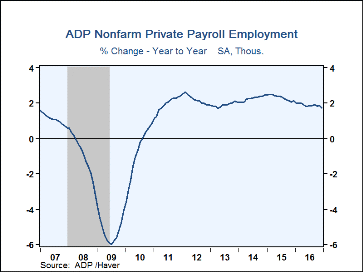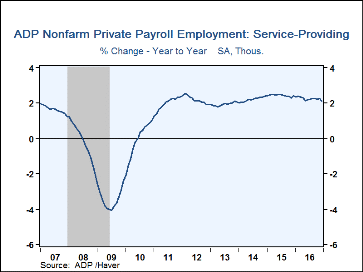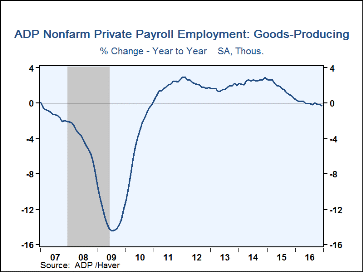 Global| Jan 05 2017
Global| Jan 05 2017U.S. ADP Private Payroll Increase Is Disappointing
by:Tom Moeller
|in:Economy in Brief
Summary
The ADP/Moody's National Employment Report indicated that private nonfarm payroll employment increased 153,000 during December following a 215,000 November rise, revised from 216,000. The October increase of 124,000 also was revised [...]
The ADP/Moody's National Employment Report indicated that private nonfarm payroll employment increased 153,000 during December following a 215,000 November rise, revised from 216,000. The October increase of 124,000 also was revised lower from 196,000. During 2016, payrolls rose an average 174,000 per month, down from 209,000 averaged in 2015, and 237,000 averaged during 2014. The latest increase compared to expectations for a 175,000 rise in the Action Economics Forecast Survey. During the last ten years, there has been a 96% correlation between the change in the ADP figure and the change in nonfarm private sector payrolls as measured by the Bureau of Labor Statistics.
The Automatic Data Processing Research Institute survey is based on ADP's business payroll transaction system covering 411,000 companies and nearly 24 million employees. The data are processed by Moody's Analytics Inc., then calibrated and aligned with the BLS establishment survey data. The ADP data cover private sector employment only.
Small-sized business payrolls increased 18,000 (1.5% y/y) after a 40,000 gain. This increase was down from 61,000 averaged last year and 91,000 averaged in 2015. Hiring by medium-sized businesses rose 71,000 (1.6% y/y) compared to 91,000 in November; the increase averaged 60,000 last year and 64,000 in 2015. Large-sized businesses posted a 63,000 increase in jobs (2.5% y/y), up from the 54,000 averaged last year and 55,000 in 2015.
Service-producing payrolls increased 169,000 (2.1% y/y) after a 221,000 rise. During 2016, service producing jobs rose an average of 179,000 per month and 200,000 per month in 2015. Jobs in trade, transportation & utilities increased 82,000 (1.7% y/y) and by 38,000 per month last year. Professional & business payrolls rose 24,000 (2.9% y/y) and by an average 47,000 last year. Education & health services employment gained 28,000 (2.4% y/y), averaging a monthly 45,000 for the year. The leisure & hospitality sector increased hiring by 19,000 (2.3% y/y) against last year's 29,000 average. Financial sector payrolls added 11,000 (2.0% y/y) and 14,000 per month in the year.
Goods-producing employment declined 16,000 (-0.3% y/y) after a 5,000 increase. Goods-producing sector employment declined an average 4,000 per month in 2016. Employment in the construction industry eased 2,000 last month (+1.2% y/y), but rose an average 7,000 per month last year. Hiring in the factory sector fell 9,000 (-0.4% y/y), and was off an average of 4,000 per month last year.
The ADP National Employment Report data are maintained in Haver's USECON database; historical figures date back to April 2001 for the total and industry breakdown, and back to January 2005 for the business size breakout. The expectation figure is available in Haver's AS1REPNA database.
How Important Is Information from FOMC Minutes? from the Federal Reserve Bank of San Francisco is available here.
| ADP/Moody's National Employment Report | Dec | Nov | Oct | Dec Y/Y | 2016 | 2015 | 2014 |
|---|---|---|---|---|---|---|---|
| Nonfarm Private Payroll Employment (m/m chg, 000s) | 153 | 215 | 124 | 1.7% | 1.9 | 2.3% | 2.3% |
| Small Payroll (1-49) | 18 | 40 | 21 | 1.5 | 1.9 | 2.3 | 1.9 |
| Medium Payroll (50-499) | 71 | 91 | 43 | 1.6 | 1.5 | 2.2 | 2.7 |
| Large Payroll (>500) | 63 | 84 | 60 | 2.5 | 2.5 | 2.5 | 2.3 |
| Goods-Producing | -16 | 5 | -13 | -0.3 | 0.0 | 1.7 | 2.5 |
| Construction | -2 | 14 | -12 | 1.2 | 2.2 | 5.0 | 5.0 |
| Manufacturing | -9 | -8 | 1 | -0.4 | -0.2 | 0.7 | 1.3 |
| Service-Producing | 169 | 221 | 137 | 2.1 | 2.2 | 2.4 | 2.2 |
Tom Moeller
AuthorMore in Author Profile »Prior to joining Haver Analytics in 2000, Mr. Moeller worked as the Economist at Chancellor Capital Management from 1985 to 1999. There, he developed comprehensive economic forecasts and interpreted economic data for equity and fixed income portfolio managers. Also at Chancellor, Mr. Moeller worked as an equity analyst and was responsible for researching and rating companies in the economically sensitive automobile and housing industries for investment in Chancellor’s equity portfolio. Prior to joining Chancellor, Mr. Moeller was an Economist at Citibank from 1979 to 1984. He also analyzed pricing behavior in the metals industry for the Council on Wage and Price Stability in Washington, D.C. In 1999, Mr. Moeller received the award for most accurate forecast from the Forecasters' Club of New York. From 1990 to 1992 he was President of the New York Association for Business Economists. Mr. Moeller earned an M.B.A. in Finance from Fordham University, where he graduated in 1987. He holds a Bachelor of Arts in Economics from George Washington University.










